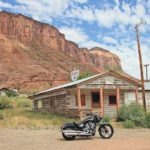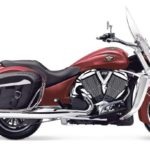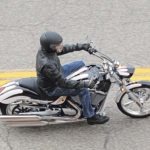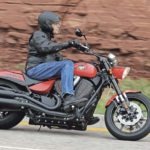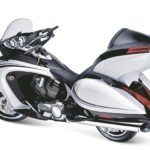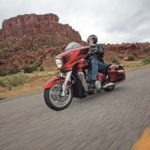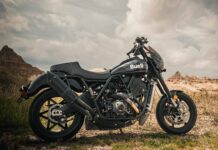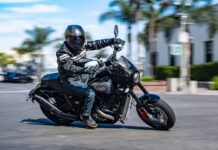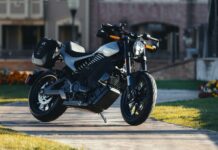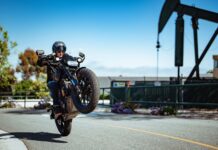Big power across the board
And all quiet on the gearbox front
Gateway, Colo., Aug. 5—“Sweet tranny.” Those are words you might expect to hear uttered at a nightclub in South Beach, but never at a Victory Motorcycles event. And yet here at the remote Gateway Canyons Resort in Colorado’s ethereal red rock country where the Victory crew—a.k.a. The Men in Black—have convened their 2011 model press introduction, that utterance is as unavoidable as it is exciting and long overdue. Now in their 14th year of production, Victory has been persistently bedeviled by its gearbox, which despite numerous reworkings and outright replacements over the years has never been a device worthy of mating up to their highly-refined, potent and bulletproof 8-valve, overhead cam V-twin motors. By the time the original V92 model was unveiled to the world in 1997, in fact, the machine was already on its second transmission—the original unit having been jettisoned and replaced from scratch mere months before the roll out. And that was a harbinger of things to come.
That replacement tranny proved a wretched mess—a noisy and cantankerous box-of-rocks that gave the young company a black eye at a most inopportune time in their growth. The engineers went back in for another go at it. In looking back over my press materials from the 2001 model launch 10 years ago, the banner technical upgrade trumpeted at the time was an “all-new transmission” that promised “less clunk and chatter—quieter and smoother shifting.” Right. They then fixed that one for 2002, and again for 2003. And so on.
Flash forward to the current press launch and the leading technical development for 2011 is—surprise!—a “new transmission.” And again it promises less noise and smoother operation. Deja vu all over again, you’d be forgiven for thinking, only this time they’re telling it straight. Gone now is the racket, the fitful downshifts, and the stubborn resistance to notching neutral at low revs. Gone too is roughly 67 percent of the driveline lash of the previous unit. Instead we have a quiet, confident, silky-shifting 6-speed overdrive box that rolls on and off power elegantly and happily clicks into neutral anytime you ask it to. Sweet tranny.
So how’d they do it?
They began by spacing the main and counter shafts an additional 6mm apart, and then reconfiguring the gear teeth and resizing the cogs to put more beef in the higher gears. They toughened up main shaft bearings and added a helical common gearset for all gears except the direct-drive 5th. They then redesigned the dogs and pockets, using varied depths and 5 degrees of tip-in ramp instead of the previous 15 to eliminate lash. To offset any additional late-downshift difficulty resulting from that alteration, they added a “countershaft drag system” to keep dogs and gears spinning in relative sync at low revs. They stiffened up the shifter forks and re-profiled the tracks on the shifter drum for slicker operation, and to facilitate finding neutral at a stop, they installed a clever little centrifugal widget called a “neutral selection assist” that works like a charm. The only downside to all of this ingenious futzing is that you can’t retrofit any of it to existing Victory transmissions. Bummer.
The upsides are many. Having effectively squelched the transmission noise, Victory could use the decibel credits they’d banked in the zero-sum game of noise emission standards and apply them to where they’re needed most—the exhaust note. The mufflers on the 2011 models have conspicuously larger outlets at the tips, and a conspicuously more pronounced and pleasing rumble. The new transmission has also allowed for the service interval of the bikes to be extended from 3,000 to 5,000 miles, largely because oil degradation is no longer the factor in the tranny’s performance that it was. Most importantly for the company going forward and forth in the international market, the driveline racket reduction brings their machines into EU compliance and opens up off-shore sales possibilities.
All 2011 Victory models come equipped with the new 6-speed, and all models also get the 106 c.i. motor this year. The 100-incher and the 5-speed gearbox have been permanently retired, and the only difference in powertrains this year is that the touring models get the Stage 1 version, producing a claimed 92 hp and 109 ft/lbs of torque, while the cruisers get the Stage 2 upgrade with its 97 hp and 113 ft/lbs. Big numbers, those.
Cruiser news
The 2011 line-up brings back a lot of familiar faces, starting with the long-running Vegas ($14,999), the oldest model in the fold and one whose inspired design has stood the test of time. It remains the company’s most popular cruiser model, and for good reason. The Kingpin ($14,999), Vegas Jackpot ($18,499), Hammer ($17,799) and Hammer S ($18,499) are here as well, as are the blackened and budget-minded 8-Ball avatars of the Vegas, Kingpin and Hammer ($12,499, $12,999, $14,499, respectively). Added to the cruiser line-up this year is Zach Ness’s tribally awesome and limited-edition treatment of the Vegas ($18,999). For those who’ve admired the Vegas styling in the past, Zach’s 2011 take on it will make you swoon.
The cruisers have more to boast this year than just the Stage 2 powertrains. The instrumentation of the bikes has been dramatically improved with a comprehensive gauge adapted from the Cross Roads, one that puts all traditional dash functions and idiot lights in a single unit with an analog speedo dial. That takes the idiot lights off of the triple tree where they resided previously (and where they were hard to see in bright sun and from certain angles) and puts them right in your face. You also get smart info on fuel level and range, the time of day, and what gear you’re operating in, as well as diagnostic readouts.
Also new for this year on the cruisers as well as the touring models are black finishes on the hand control switch modules, lower belt guards, floorboards, brake calipers and rotors.
Going the distance
Officially there are six touring models in the 2011 stable, the Vision Tour ($23,199), Vision 8-Ball ($17,999), Arlen Ness Vision ($27,999), Cross Country ($17,999), Cory Ness Cross Country ($24,999) and the Cross Roads ($14,999), but that figure is misleading when you factor in the Cross Roads CORE Custom Program. This novel program essentially makes the Victory dealer the final assembly point for the Cross Roads. It’s there that the basic model—stocked in two colors, black and crimson—is accessorized to the customer’s preference from a buffet of inventoried options and rolled out the door. The basic $14,999 Cross Roads comes with soft saddlebags, and sans windscreen and crash bars, so the customer can add hard bags for $250, tubular front bars for $350 or forged bars for $600, and rear bars for $300. The company figures there are 48 possible variations available, and a fully-dressed bike retails for $16,699. The Cross Roads is intended to compete directly with Harley’s Road Kings, both the standard and the Classic, and with the CORE program they cover both of those bases tidily and economically—relatively speaking.
Cruise control is a stock amenity on all of the touring models for 2011, and the Vision Tour and Arlen Ness Signature Series version of the bike both come with ABS standard. The heel/toe shifter on the bikes has been replaced with a toe shifter only, with a bolt-on heel shifter offered as an option. Also offered this year for both the Cross Roads and Cross Country is a quick-detach trunk, and it’s an impressive piece of work. It has a huge carrying capacity capable of holding a pair of full-face helmets, an accessory power outlet for keeping your toys charged on the go and a lock that works with your ignition key. You can add it at any time after your initial bike purchase since all Cross Roads and Cross Country motorcycles include a spare lock cylinder for retrofitting to the trunk. Combine that unit with the generous capacity of the hard bags on the bikes, and you have the most capacious secure cargo area of any mount on the market—including the Vision Tour.
Not surprisingly, the Ness Signature Series treatments offered this year are the most desirable of the lot and they carry surprisingly reasonable price tags for what they bring to their respective platforms. All three generations of the First Family of Customizing got into the act this year, and the models they’ve applied their artistry to reflect pretty accurately the target generational cohorts of the creations. Figure Boomers for Arlen’s Vision, X’ers for Corey’s Cross Country, and Those Damn Kids for Zach’s Vegas. All three bikes feature oodles of custom billet components, eye-popping paint and graphics, and diamond-cut cylinder fins. We’re particularly enraptured by Corey’s creation, which may well be the most perfectly balanced combination of serious road chops and custom elan on the market. (We’ll be publishing a more thorough review of the model in an upcoming issue.)
One last detail worth noting for 2011 is that Victory Motorcycles—probably the most brand-conscious company in the industry—has done the unthinkable and ceased to call themselves “The New American Motorcycle.” After all these years that promo began to sound dated, apparently, and they weren’t excited about changing it to “The Newish American Motorcycle” so they went with “Fuel It.” Whatever. What’s most important here is that the company is, indeed, still on the gas development-wise and still enthused about what they’re doing and it’s palpable when spending any time at all with The Men in Black. They’ve got their work cut out for them in growing the company in this economy, but they also have a lot going for them this year—and going quietly. Sweet tranny.


